Characterization and Analysis of the Mortars in the Church of the Company of Jesus—Quito (Ecuador)
Abstract
:1. Introduction
2. Materials and Methods
2.1. Materials
2.2. Methods
3. Results
4. Discussion
5. Conclusions
Author Contributions
Funding
Data Availability Statement
Acknowledgments
Conflicts of Interest
References
- UNESCO City of Quito. Available online: https://whc.unesco.org/en/list/2/ (accessed on 1 May 2021).
- Fustillos, A. Encuentro Científico Internacional sobre Ciudades Históricas Iberoamericanas. In San Francisco de Quito; la Mancha, I.-U.C., Ed.; Servicio de publicaciones de la Universidad de Castilla-La Mancha: Cuenca, Spain, 2005; pp. 246–273. [Google Scholar]
- Ortiz Crespo, A. Arquitectura Monumental del Centro Histórico de Quito; TRAMA: Quito, Ecuador, 1990; pp. 141–164. [Google Scholar]
- Lara, M.L.; Sanz, D.; Del Pino, I. Morteros históricos en las construcciones de Quito de los siglos XVI, XVII y XVIII. Ge-conservacion 2020, 17, 71–81. [Google Scholar] [CrossRef]
- Martínez, I.d.P. Centro Histórico de Quito: Una Centralidad Urbana en Transformación Hacia el Turismo. 2001–2008; FLACSO sede Ecuador: Quito, Ecuador, 2009. [Google Scholar]
- Patrimonio, I.M. de Diagnóstico del Centro Histórico de Quito. Available online: http://www7.quito.gob.ec/mdmq_ordenanzas/Comisiones del Concejo/Uso de Suelo/Centro Histórico/Información IMP/Plan Parcial Centro Histórico/1. Diagnóstico del CHQ.pdf (accessed on 1 May 2020).
- Alcalá, L.E. De historias globales y locales: Una aproximación a la historiografía de la arquitectura de los Jesuitas en Hispanoamérica. In La Arquitectura Jesuítica: Actas del Simposio Internacional, Zaragoza, 9, 10 y 11 de Diciembre de 2010; Instituto “Fernando El Católico”: Zaragoza, Spain, 2012; pp. 473–496. [Google Scholar]
- Navarro, J.G. Arquitectura Americana: La Iglesia de la Compañía de Jesús en Quito; Biblioteca Virtual Miguel de Cervantes: Alicante, Spain, 2011. [Google Scholar]
- Jouanen, J. Historia de la Compañía de Jesús en la Antigua Provincia de Quito: 1570–1773, Tomo II 2005; Biblioteca Virtual Miguel de Cervantes: Alicante, Spain, 2005; p. 787. [Google Scholar]
- Jouanen, J. Historia de la Compañía de Jesús en la Antigua Provincia de Quito 1570–1774; Editorial Ecuatoriana: Quito, Ecuador, 1941; pp. 1570–1696. [Google Scholar]
- Samaniego, D.D. Diccionario arquitectónico de Quito. In Quito Museos del Banco Cent; Museos del Banco Central del Ecuador Quito: Quito, Ecuador, 1983; p. 54. [Google Scholar]
- Martínez, I.d.P.; Yepes, H. Apuntes para una historia sísmica de Quito. In Centro Histórico de Quito: Problemática y Perspectivas, Serie Quito; Junta de Andalucía, Municipio de Quito: Quito, Ecuador, 1990; pp. 67–100. [Google Scholar]
- Moropoulou, A.; Polikreti, K.; Ruf, V.; Deodatis, G. San Francisco Monastery, Quito, Equador: Characterisation of building materials, damage assessment and conservation considerations. J. Cult. Herit. 2003, 4, 101–108. [Google Scholar] [CrossRef]
- Beltrán, J.; De Vuyst, P.; Rosero, M. Conservación del Patrimonio Artístico del Convento de Santo Domingo; Ecua-bel, P., Ed.; Libri Mund: Quito, Ecuador; Ediciones Libri Mundi: Madrid, Spain, 1994; Volume 6, ISBN 9978-57-014-4. [Google Scholar]
- Santander, D.G. Un templo vivo. Sentido y misión de la restauración del templo y Colegio de los jesuitas en Quito. In Radiografía de la Piedra; FONSAL Fondo de Salvameno de Quito: Quito, Ecuador, 2008; pp. 309–337. ISBN 978-9978-36-603-5. [Google Scholar]
- Navarro, J.G. Artes Plásticas Ecuatorianas; Fondo de Cultura Económica: Madrid, Spain, 1945; p. 25. [Google Scholar]
- Moreno Egas, J. Radiografía en la Piedra: Los Jesuitas y su Templo en Quito, 17th ed.; FONSAL—Fondo de Salvameno de Quito: Quito, Ecuador, 2008; ISBN 978-9978-36-603-5. [Google Scholar]
- Piñas Rubio Francisco, S.I. El Arquitecto Hermano Marcos Guerra S.J. y su Obra; Biblioteca Virtual Miguel de Cervantes: Alicante, Spain, 2008. [Google Scholar]
- Micó Buchón, J.L. La iglesia de la Compañía de Quito; Fundación Pedro Arrupe, Residencia de San Ignacio: Quito, Ecuador, 2003; ISBN 9978427023. [Google Scholar]
- Ospina, P. Dos personales y una perspectiva de la arquitectura y el urbanismo n la Colonia. In Arquitectura de Quito: Una Visión Histórica de su Arquitectura; España, D., Ed.; TRAMA: Quito, Ecuador, 1993; pp. 91–114. [Google Scholar]
- D’Ercole, R.; Metzger, P. Los Lugares Esenciales del Distrito Metropolitano de Quito; Colección Quito Metropolitano: Quito, Ecuador, 2002; ISBN 9978-970-45. [Google Scholar]
- Escudero Albornoz, X. Escultura Colonial Quiteña: Arte y Oficio-Ximena Escudero-Albornoz-Google Libros; TRAMA: Quito, Ecuador, 2007; ISBN 9978-300-40-6. [Google Scholar]
- Comité técnico AEN/CTN 41 UNE-EN 16085. Conservación del Patrimonio Cultural. Metodología para la Toma de Muestras de Materiales del Patrimonio Cultural; UNE: Madrid, Spain, 2014. [Google Scholar]
- Veiga, M.R.; Aguiar, J.; Silva, A.S.; Carvalho, F. Methodologies for characterisation and repair of mortars of ancient buildings. In Proceedings of the 3rd International Seminar Historical Constructions, Guimarães, Portugal, 7–9 November 2001; pp. 353–362. [Google Scholar]
- Válek, J.; Hughes, J.J.; Bartos, P. Compatibility of historic and modern lime mortars. In Proceedings of the 12th International Brick/Block Masonry Conference, Madrid, Spain, 25–28 June 2000; p. 1839. [Google Scholar]
- Alonso-Olazabal, A.; Ortega, L.A.; Zuluaga, M.C.; Ponce-Antón, G.; Echevarría, J.J.; Fernández, C.A. Compositional characterization and chronology of roman mortars from the archaeological site of arroyo de la dehesa de velasco (Burgo de osma-ciudad de osma, Soria, Spain). Minerals 2020, 10, 393. [Google Scholar] [CrossRef]
- Pacheco, D.; Andrade, D.; Alvarado, A. Estratigrafía Cuaternaria de la Cuenca San Antonio de Pichincha. Rev. Politéc. 2014, 33, 1–9. [Google Scholar]
- Andrade, S.D.; Martin, H.; Monzier, M. Restricciones y un posible modelo para la génesis de los magmas del volcán Pululahua (Ecuador). Rev. Politéc. 2014, 33, 1–13. [Google Scholar]
- Viteri, F. Estudio de zonificación territorial de las zonas de explotación de materiales de construcción en el municipio del Distrito Metropolitano de Quito. In Canteras Escuelas en Iberoamerica; Composicáo e Execuáo Gráfica, Ed.; CYTED-CETEM: Río de Janeiro, Brazil, 2001; pp. 87–98. [Google Scholar]
- Martinet, G.; Quenee, B. Proposal for a useful methodology for the study of ancient mortars. In Proceedings of the International RILEM Workshop on Historic Mortars: Characteristics and Tests, Paisley, UK, 12–14 May 1999. [Google Scholar]
- Martínez, T.L.; García, M.R.B.; Bueno, A.G. Metodología para el estudio de morteros arqueológicos de revestimiento. Ge-conservacion 2021, 19, 31–44. [Google Scholar] [CrossRef]
- Allen, G.C.; Hallam, K.R.; Radonjic, M.; Elton, N.J.; Farey, M.; Ashurst, J. X-ray diffraction and enviromental electron microscopy of hydrated limes. In Proceedings of the International RILEM Workshop on Historic Mortars: Characteristics and Tests, Paisley, UK, 12–14 May 1999; pp. 207–215. [Google Scholar]
- Middendorf, B.; Baronio, G.; Callebaut, K.; Hughes, J. Chemical-mineralogical and physical-mechanical investigations of old mortars. In Proceedings of the International RILEM Workshop on Historic Mortars: Characteristics and Tests, Paisley, UK, 12–14 May 1999; pp. 55–62. [Google Scholar]
- Chung, F.H. Quantitative interpretation of X-ray diffraction patterns of mixtures. III. Simultaneous determination of a set of reference intensities. J. Appl. Crystallogr. 1975, 8, 17–19. [Google Scholar] [CrossRef]
- Ampatzioglou, E.; Karatasios, I.; Colston, B.; Watt, D.; Kilikoglou, V. Lime-Natura Pozzolan Conservation Mortars: Parameter that Affect Reactivity and Strength. In HMC 2010 and RILEM TC 203-RHM Final Workshop, Proceedings of the 2nd Conference on Historic Mortars, Prague, Czech Republic, 22–24 September 2010; RILEM Publications SARL: Prague, Czech Republic, 2010. [Google Scholar]
- Whitney, D.L.; Evans, B.W. Abbreviations for names of rock-forming minerals. Am. Mineral. 2010, 95, 185–187. [Google Scholar] [CrossRef]
- Carran, D.; Hughes, J.; Leslie, A.; Kennedy, C. A Short History of the Use of Lime as a Building Material beyond Europe and North America. Int. J. Archit. Herit. 2012, 6, 117–146. [Google Scholar] [CrossRef]
- Rodríguez-Navarro, C. Binders in historical buildings: Traditional lime in conservation. Semin. SEM 2012, 9, 91–112. [Google Scholar]
- Böke, H.; Akkurt, S.; Ipekoǧlu, B.; Uǧurlu, E. Characteristics of brick used as aggregate in historic brick-lime mortars and plasters. Cem. Concr. Res. 2006, 36, 1115–1122. [Google Scholar] [CrossRef]
- Hall, M.L.; Samaniego, P.; Le Pennec, J.L.; Johnson, J.B. Ecuadorian Andes volcanism: A review of Late Pliocene to present activity. J. Volcanol. Geotherm. Res. 2008, 176, 1–6. [Google Scholar] [CrossRef]
- Ortiz Crespo, A. Desde la primera piedra hasta la expulsión: 160 años de historia constructiva. In Radiografía de la Piedra: Los Jesuitas y su Templo en Quito; FONSAL—Fondo de Salvamento de Quito: Quito, Ecuador, 2008; pp. 173–210. ISBN 978-9978-36-603-5. [Google Scholar]
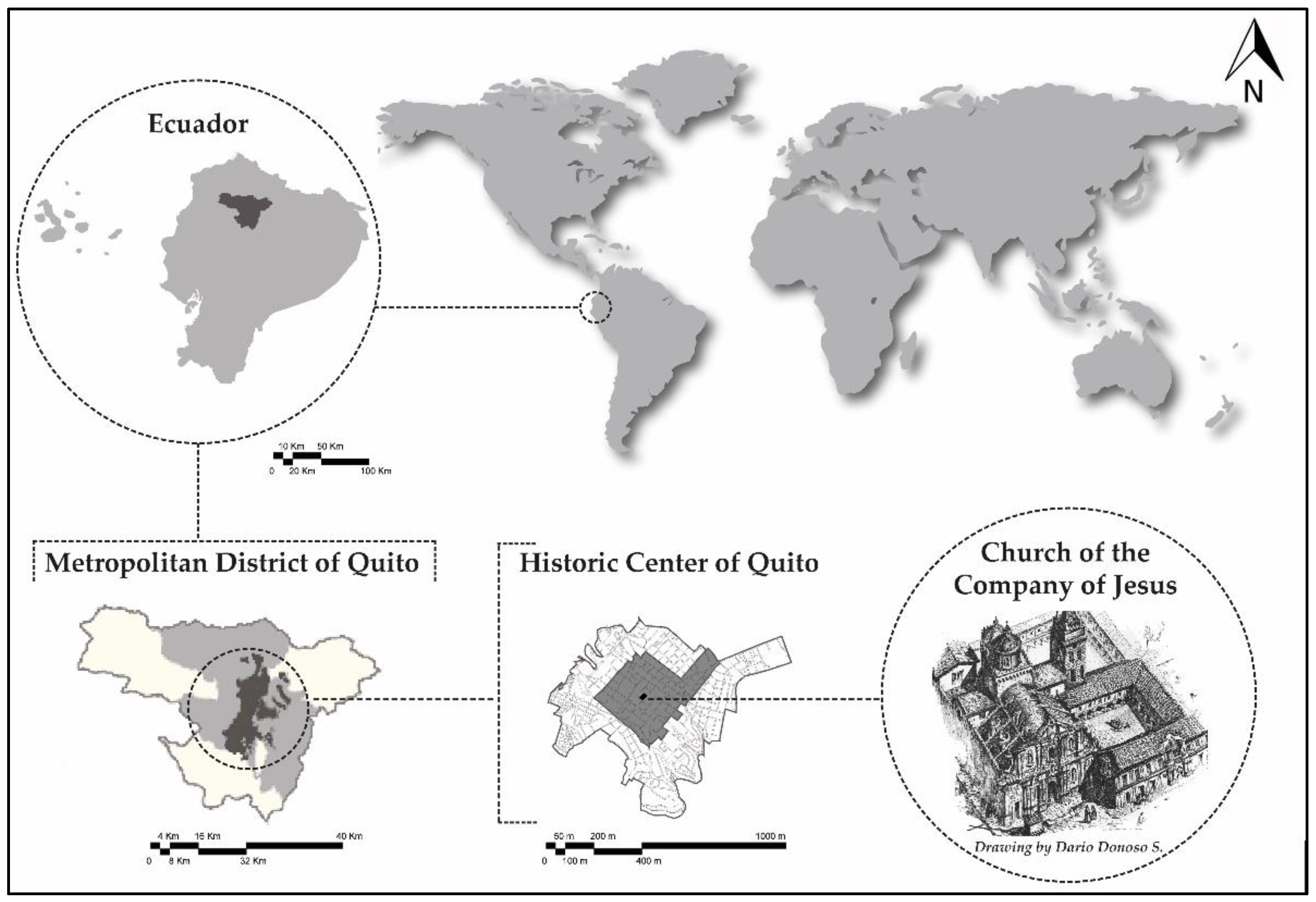
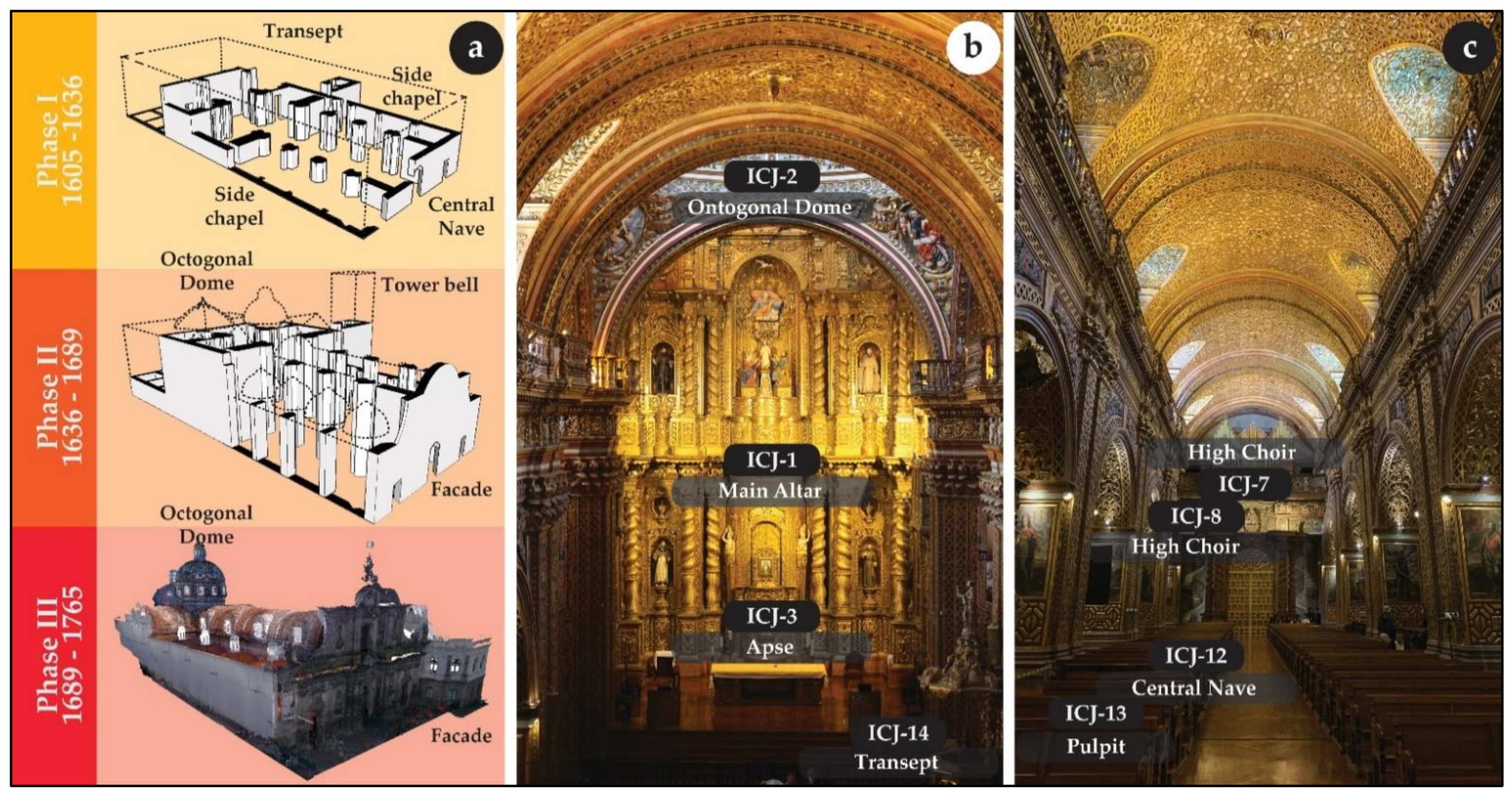

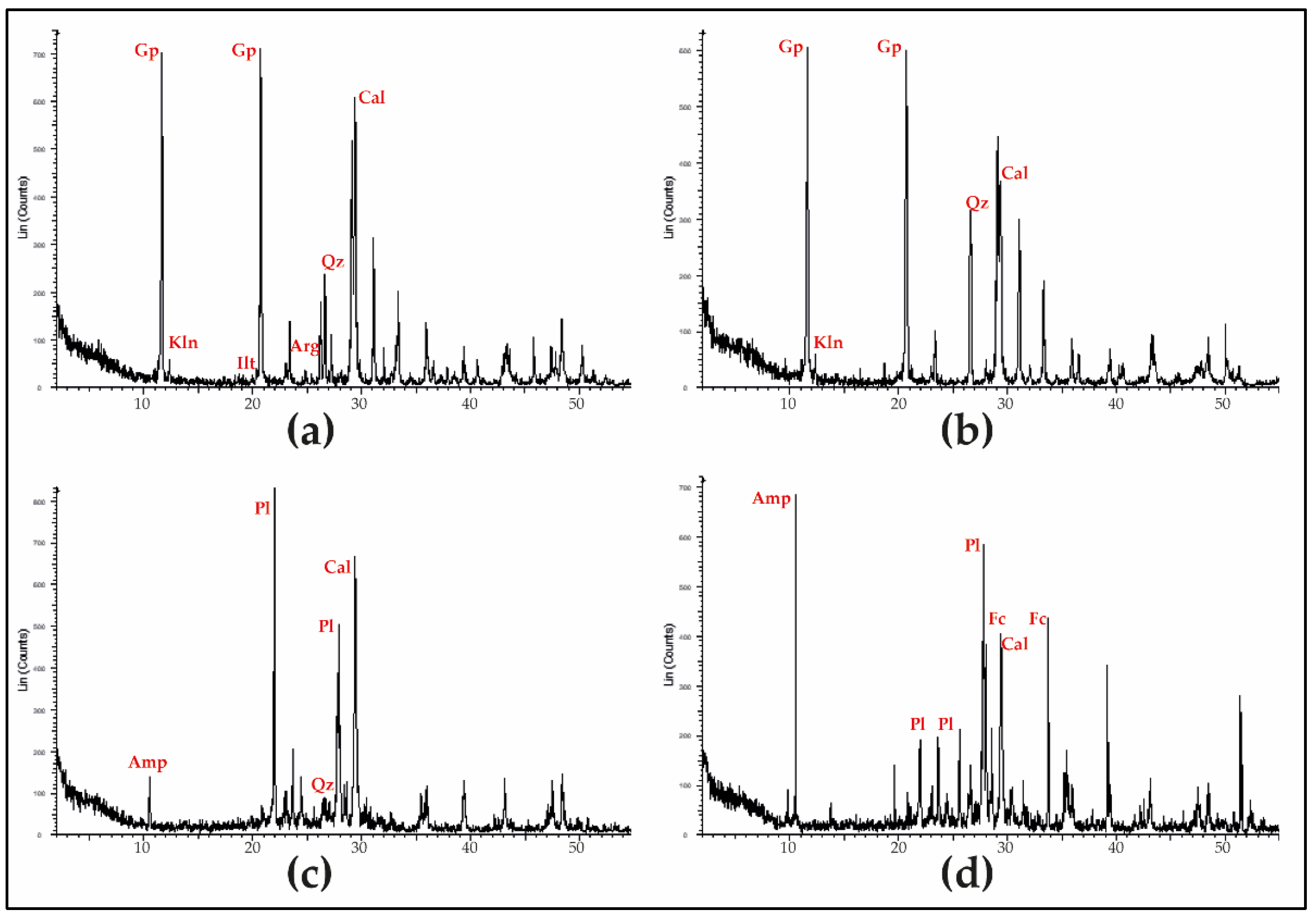
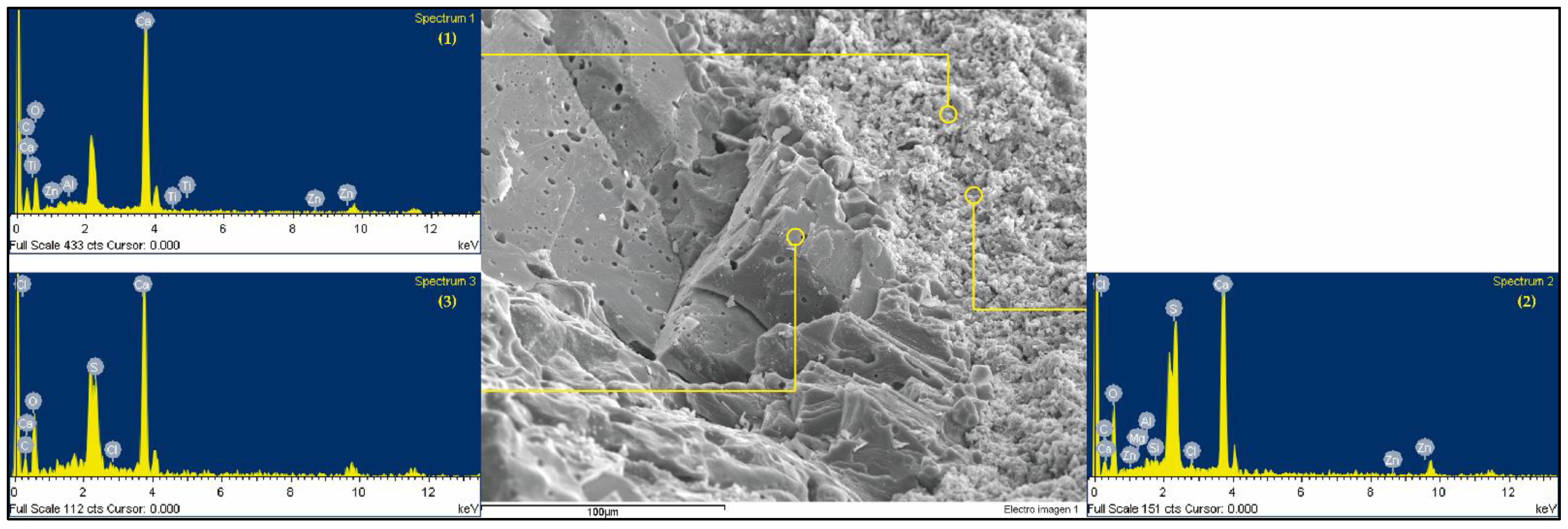
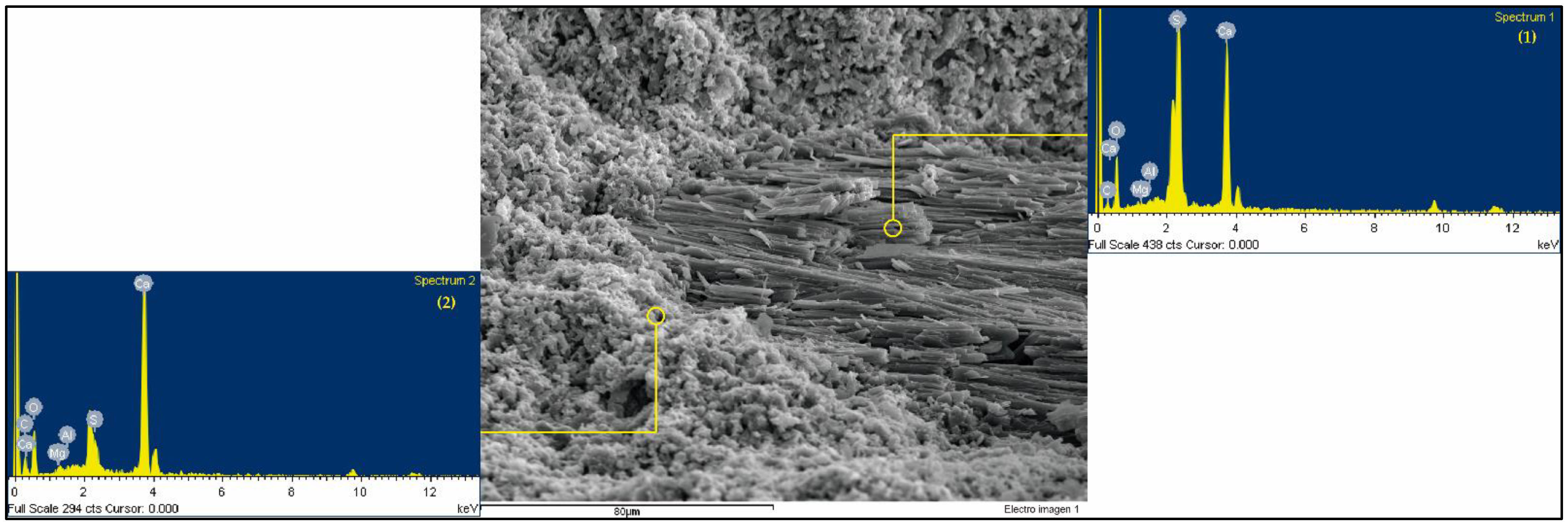

| Samples | Qz | Pl | Kfs | Ilt | Amp | Cal | Arg | Fc | Gp | Other |
|---|---|---|---|---|---|---|---|---|---|---|
| ICJ-10 | 3 | 75 | 9 | 8 | 3 * | |||||
| ICJ-1 | 7 | 8 * | 25 | 18 | 42 | |||||
| ICJ-2 | 4 | 5 | 72 | 19 | ||||||
| ICJ-3 | 3 | 70 | 7 | 20 | ||||||
| ICJ-13 | 2 | 58 | 6 | 6 | 20 | 8 | ||||
| ICJ-14 | 5 | 42 | 8 # | 16 | 18 | 11 ** | ||||
| ICJ-7 | 2 | 64 | 10 | 24 | ||||||
| ICJ-8 | 2 | 61 | 18 | 19 | ||||||
| ICJ-12 | 72 | 4 | 9 | 7 | ||||||
| ICJ-4 | 2 | 50 | 24 | 9 | 15 | |||||
| ICJ-5 | 19 | 5 # | 23 | 53 | ||||||
| ICJ-6 | 2 | 67 | 20 | 9 | 2 *** |
| Samples | Mortar |
|---|---|
| ICJ-1 | Lime and gypsum plaster |
| ICJ-2 | Lime and gypsum plaster with carbonate aggregates |
| ICJ-3 | Lime joint mortar with volcanic aggregates |
| ICJ-13 | Lime joint mortar with volcanic aggregates |
| ICJ-14 | Lime joint mortar with volcanic aggregates |
| ICJ-7 | Lime joint mortar with volcanic aggregates |
| ICJ-8 | Lime joint mortar with volcanic aggregates |
| ICJ-12 | Lime joint mortar with volcanic aggregates |
| ICJ-4 | Lime joint mortar with volcanic aggregates and fire evidence minerals |
| ICJ-5 | Lime and gypsum plaster with carbonate aggregates |
| ICJ-6 | Lime joint mortar with volcanic aggregates |
Publisher’s Note: MDPI stays neutral with regard to jurisdictional claims in published maps and institutional affiliations. |
© 2021 by the authors. Licensee MDPI, Basel, Switzerland. This article is an open access article distributed under the terms and conditions of the Creative Commons Attribution (CC BY) license (https://creativecommons.org/licenses/by/4.0/).
Share and Cite
Lara, M.L.; Sanz-Arauz, D.; López-Andrés, S.; Pino, I.d. Characterization and Analysis of the Mortars in the Church of the Company of Jesus—Quito (Ecuador). Minerals 2021, 11, 781. https://doi.org/10.3390/min11070781
Lara ML, Sanz-Arauz D, López-Andrés S, Pino Id. Characterization and Analysis of the Mortars in the Church of the Company of Jesus—Quito (Ecuador). Minerals. 2021; 11(7):781. https://doi.org/10.3390/min11070781
Chicago/Turabian StyleLara, M. Lenin, David Sanz-Arauz, Sol López-Andrés, and Inés del Pino. 2021. "Characterization and Analysis of the Mortars in the Church of the Company of Jesus—Quito (Ecuador)" Minerals 11, no. 7: 781. https://doi.org/10.3390/min11070781
APA StyleLara, M. L., Sanz-Arauz, D., López-Andrés, S., & Pino, I. d. (2021). Characterization and Analysis of the Mortars in the Church of the Company of Jesus—Quito (Ecuador). Minerals, 11(7), 781. https://doi.org/10.3390/min11070781







